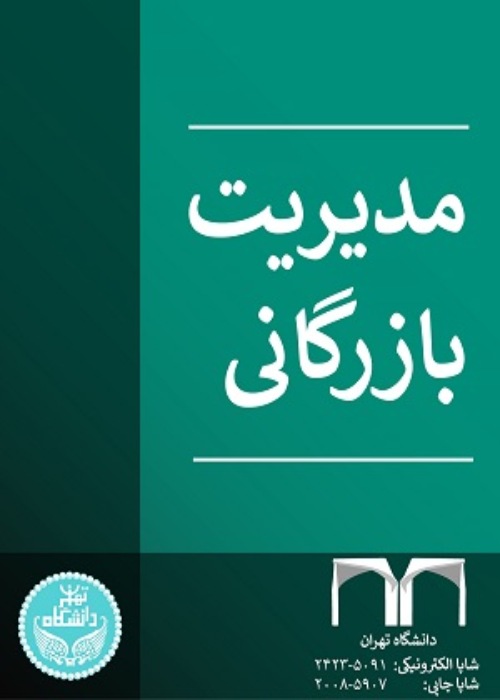Analysis of Customer Engagement in Creating Value at Different Stages of the Relationship Life Cycle
Author(s):
Article Type:
Research/Original Article (دارای رتبه معتبر)
Abstract:
Objective
Increasing competitive environment among businesses as well as the importance of attracting new customers and maintaining the existing customers have led to reform in customer management approaches. Currently, along with technological and internet-based development and advancement as well as formation of online social media, an appropriate infrastructure for social communication and sharing experiences have been created. Such environmental changes can help evolve customers’ relationship with the companies and pave the way for the new concept of customer engagement which the researchers believe can significantly increase profitability. According to dynamic systematic marketing theories, we can consider life cycle factor for relationships just like products i.e. the relationship between customers and companies change throughout time. Although only a few studies have investigated the effect of customer engagement on customer-firm life cycle and also customers’ value creation in relationship life cycle, academicians and business managers need to conduct empirical studies in order to gain a better understanding of the value of the customer’s engagement in relationship life cycle. Therefore, the present study, we aim to respond to the following questions:
Do different customers have the same degree of enthusiasm to engage in creation of values for the companies?What kinds of values are sought by the customers of different relationship life cycle?
Methodology
This study is applied in nature and descriptive in terms of methodology. The population of the study includes all the customers of different branches of Parsian Insurance Company in Tabriz. The population was considered as infinite and a sample size of 386 customers was selected according to Cochran approach and based on non-incidental availability of the customers. The participants in the present study were selected from among actual insurance users. The data were collected using questionnaires. 520 questionnaires were distributed in order to receive at least 386 completed ones. All 52 branches of Parsian Insurance Company were investigated in order to reduce the ethnicity judgmental error. Cronbach alpha, Composite Reliability (CR), and Average Variance Extracted (AVE) reliability measures were used. Besides, content and construct (convergent and divergent) validity measures were sought. Content validity was measured using experts’ opinions. Finally, variance analysis was used to test the research hypotheses.Findings
We can conclude that the highest customer engagement rate occurs within the third stage (maturity or maintenance) of the relationship life cycle where the nature of the relationship between the customer and the firm is more intimate. In the developing and maintaining stages of the relationship, the customers are willing to directly (repurchasing) and indirectly (introducing new customers, influencing others and giving feedback) engage in creating of values to the Insurance Company. Due to the lack of comprehensive knowledge of the firm and limited trust, in the early stages (cognitive stage) of the relationship, customer’s engagement in value creation is lower. Similarly, in the final stages of the relationship (decline in relationship), direct (customers’ life cycle value) and indirect (reference value, influence value and customers’ awareness value) engagement reduces significantly. In general, as the relationship progresses the willingness to engage in such activities increases and reaches the apex in the maturity stage and the engagement reduces as the customers enter the final stage of the relationship. Variance Analysis test shows different customer’s engagement within different stages of the relationship between the customer and the firm.Conclusion
The present study has helped improve the customer engagement marketing literature in different ways: a first, we suggest that customer engagement value is dynamic because of the relationship dynamism theory and that such value increases as the relationship progresses. Besides, this study provides an empirical test based on the proposed framework regarding insurance services and shows that the customers’ engagement in value creation differs from one stage to another. Third, the few studies regarding customer engagement are conducted in developed countries and the present study is the first one conducted in a developing country like Iran, so it can help enrich this area of researchKeywords:
Language:
Persian
Published:
Quarterly Journal of Business Management, Volume:11 Issue: 39, 2019
Pages:
105 to 124
magiran.com/p1937747
دانلود و مطالعه متن این مقاله با یکی از روشهای زیر امکان پذیر است:
اشتراک شخصی
با عضویت و پرداخت آنلاین حق اشتراک یکساله به مبلغ 1,390,000ريال میتوانید 70 عنوان مطلب دانلود کنید!
اشتراک سازمانی
به کتابخانه دانشگاه یا محل کار خود پیشنهاد کنید تا اشتراک سازمانی این پایگاه را برای دسترسی نامحدود همه کاربران به متن مطالب تهیه نمایند!
توجه!
- حق عضویت دریافتی صرف حمایت از نشریات عضو و نگهداری، تکمیل و توسعه مگیران میشود.
- پرداخت حق اشتراک و دانلود مقالات اجازه بازنشر آن در سایر رسانههای چاپی و دیجیتال را به کاربر نمیدهد.
In order to view content subscription is required
Personal subscription
Subscribe magiran.com for 70 € euros via PayPal and download 70 articles during a year.
Organization subscription
Please contact us to subscribe your university or library for unlimited access!


